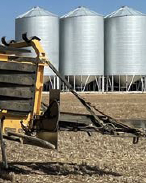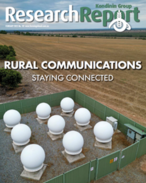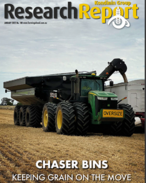This article is 7 years old. Images might not display.
In the past four years, we have seen an increase in RGB activity, perhaps because of wetter conditions generally,” Melina said.
“Last year was a highpressure year for all sorts of bugs, especially RGB. Until these last few years, the last time we saw a big outbreak in sorghum was 2007.
“One of the situations that is challenging agronomists and growers is the management of Rutherglen bug nymphs and adults emerging en masse from canola stubble in late spring,” Melina said.
“The movement is an exodus out of the stubbles as they dry off, rather than directed movement towards summer crops.”
Rutherglen bug (Nysius vinitor) is a native species that feeds on a wide variety of native and exotic plant species. Although primarily a seed feeder, the sheer weight of their numbers feeding of plants causes damage to seedling crops.
QDAF entomologists have done some preliminary work on the management of these mass movements from canola, and further investigation is a priority for 2017.
Repeated spraying of crop edges slows the movement of the RGB further into the summer crop, but does not prevent the death of plants in rows closest to the canola.
Seed treatments on the summer crops may also reduce the extent to which RGB move into summer crops, but again do not prevent plant loss on the field edges. The movement from the canola stubble can continue for weeks, depending on the size of the canola field.
“In southern Australia, the same movement occurs but is of little consequence as there are no nearby summer crops,” Melina said.
“For growers considering sowing summer crops in close proximity to canola, monitoring for RGB movement in spring is a must.
“RGB in canola stubble is not considered a problem by all growers. In central NSW, the RGB feed on and kill canola regrowth, volunteers and weeds and this is appreciated by growers as a benefit.
“In the early days of growing canola, RGB was considered a pest but gets less attention as a pest of canola these days. I suspect it may be a problem in some situations, potentially lowering yields in heavily infested crops if present during pod fill.”
CONTROLLING RGB
“In crops where we know a lot about the damage that RGB causes, such as sorghum and sunflower, we have very good management strategies, including thresholds for damage and treatment,” Melina said.
“In canola, we don’t have thresholds to avoid crop loss, or to prevent build-up of the RGB in stubble. There hasn’t been any research on these aspects to date.”
RGB is a migratory species, with populations of the bug moving as food sources diminish. This behaviour means that crops can be repeatedly infested, making it appear that control is not having any impact, as RGB numbers do not appear to be reduced by spraying.
“Under high RGB pressure, achieving good levels of control is challenging. When RGB populations are large it is difficult to get good direct contact on all individuals,” Melina said.
“Adults, and particularly nymphs, are mobile on the plant and hide under leaves and in the heads. In a situation like this, the residual efficacy of the insecticides becomes important; that is, how long they are toxic after spraying when RGB make contact with dry residues on leaves, stems or heads.
“In 2016-17, RGB populations were extremely high, and they persistently migrated into crops for weeks. At the same time, heatwave conditions were affecting sorghum crops. In combination, the RGB and the heat resulted in many sorghum crops with low yields and poor quality.
“As if this wasn’t enough, control of RGB proved to be a challenge for some. Agronomists and growers started to question the efficacy of products and the possibility that RGB were resistant to some insecticides.”
In response to the challenges with effective control of RGB in 2016-17, QDAF entomologists screened a large number of insecticides to evaluate both contact and residual efficacy.
They tested a suite of products, introducing RGB adults to leaves that had been treated with different products three and seven days after spraying, then assessing the number of RGB adults alive and dead after 24 hours of exposure to treated leaves.
“Our results clearly showed that the residual efficacy of treatments varies,” Melina said.
“When the bug is in high numbers and very mobile, the residual efficacy is very important for control. New bugs will show up all the time; it’s not enough to just kill the ones that are present at the time of spraying.”
This influx of new bugs may make it seem as if spray is not working, and growers may believe the bugs are resistant, but this is not the case.
“Resistance is rarely a problem in highly mobile species,” Melina said.
“We have reports of growers spraying and spraying for RGB and it seemingly having little impact on the population, but this is very unlikely to be due to resistance, but is rather because of the continuing influx of bugs or the hatching of new nymphs from eggs that were laid before the chemical control was applied.
“In the northern region, the product of choice in controlling RGB in sorghum for many growers and agronomists is alphacypermethrin. However, this product is not registered specifically for use on RGB, but can be used to control helicoverpa in the crop. The surprise finding from the 2017 trials was that the residual efficacy of alphacypermethrin (e.g. AlphaScud 400 mL/ha) rapidly deteriorates post spray. Trial data shows efficacy at 40% RGB killed at three days post spraying, and 20% RGB killed by seven days following spraying.
“In contrast, dimethoate (e.g Rogor, 250 mL/ha) killed 98% of RGB at three days post spraying, and 80% of RGB at seven days post spraying.”
Contact:
Dr Melina Miles, Queensland DAF
0407 113 306






















